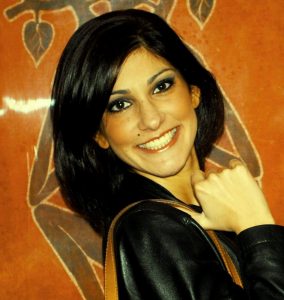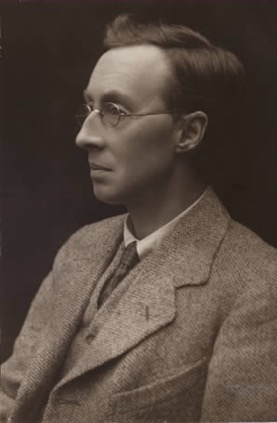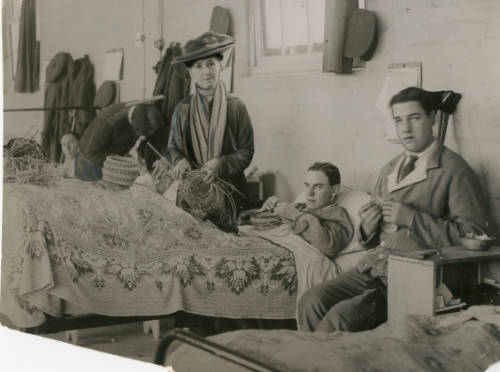
In the latest of our volunteer blog posts, Maria Chiara Scuderi explores the life of Harry Hardy Peach, one of our founders.
Did you know that Harry Hardy Peach, an important benefactor for the New Walk Museum, was also one of the founders of the University College Leicester?
The So that they may have life project has created an opportunity to examine the role Harry Peach played in developing the Arts & Crafts movement in Leicester. His passion and dedication to design and education is revealed through the fabrics, basketwork, wooden figures, and ornaments in the New Walk Museum. However, the lesser know aspect about the international networks and intellectual exchanges which created the collection, can be found in the University of Leicester Archives.

I was working on my PhD proposal when I found out about the So that they may have life project. Although I knew about Harry Peach, within the global artistic context, I was surprised to find out about his role as a founding father of my University. I knew that the library at the School of Law is dedicated to him, I knew that the metalwork at the entrance of the Fielding Johnson Building was created by the business he established – the Dryad Handicrafts company. However, I could not imagine that he donated over 1600 books to the library and numerous other prints and objects. Among them is a Sikh manuscript, a beautiful example of material culture from the Anglo-Sikh wars which illustrated a fascination with the Indian world, along with many objects preserved in the storage of the New Walk Museum.
Conducting further research on Harry Peach is a great opportunity to deepen my knowledge about his wider contribution to life in Leicester. I decided to take part in the historical research, as I love to understand history through the relationships that the archive can reveal. This is a place where letters, catalogues and photography can make stories come alive. Using this perspective, I can discover and interpret contents, and shape new insights and narratives.
So, my research started with the analysis of three boxes of documents at the Special Collections of the David Wilson Library . What struck me at the first glance was the international aspect of Peach’s dense correspondence. He had exchanges with directors of important museums, such as the Victoria and Albert Museum in London, the Historisches Museum in Hannover and the Royal Museum of Central Africa in Tervuren. Then, an interest in the international context of the Arts & Crafts movement clearly arises in the letters, especially the educational value of the manual work and its therapeutic potential to help people with physical and mental disabilities. This is common in Peach’s writings and practices. Let’s think about what he wrote in Craftmen all. Some readings in Praise of Making and Doing:
There are still, in these days of the machine, people who love their work and take pride in it for its own sake, no matter how humble their craft, and it is the spirit we must keep alive if we are to carry on the English tradition
H. H. Peach, 1926, Craftmen All. Some Readings in Praise of Making and Doing.
Art was conceived as a broader process of de-modernisation, the principle of a society where people have creative capacity, and ethics and aesthetics are complementary values. A very romantic idea that came from the Victorian age, and finds one of the main supporters in John Ruskin. When industrialisation and capitalism flourished, Ruskin campaigned against dehumanisation of society, machanistic education and climate change. He considered the process of making art the solution to social inequality and the best way to understand the world.
This philosophy was translated into practice during World War I, when Peach promoted the use of craft work as part of the rehabilitation programmes for wounded and disabled ex-servicemen treated at the Base Hospital of the 5th Northern General, now the Fielding Johnson Building. He donated large quantities of cane and craft materials for use in occupational therapy, before setting up Dryad Handicraft industry, which was the largest supplier of craft materials at that time in the world.

Now someone might ask: why are you interested in the Arts & Crafts movement if this has been considered unfashionable since the 1960s? The values of the Arts & Craft movement – such as simplicity, utility, creativity and beauty – are still revolutionary, now more than ever. It is no coincidence that Arts & Crafts movement emerged in England when the industrial revolution showed the limits of machine-based productivity. It was a resistance to the revolution, and a revolution itself. By proposing the social and community value of slow and manual production, the artistic movement aimed to oppose industrial mass production and the isolated work in factories. The big dream was to reorganize the world and society based on principles opposed to the emergent model of ‘success’. With radical changes in the daily life, the movement wanted to reverse the paradigm of success defined by the modern world, redefine priorities and rethink individual identities within the common good.
I am very much looking forward to working with other volunteers to discover micro-stories behind the Arts & Crafts movement in Leicester!
Maria Chiara Scuderi is an art historian and museum practitioner broadly interested in the role of museums as politically-engaged actors within the society, particularly colonial material culture and the power relationships in shaping controversial narratives of the Empire. She arrived at the University of Leicester with an AHRC scholarship for a Master in Art Museum and Gallery Studies, then obtained a collaborative PhD to analyse what linkages with the global and Imperial context the collections at New Walk Museum and Art Gallery can reveal. You can follower her on Twitter @MariaChiaraScu
One thought on “Harry Peach and the educational and social role of handicraft, by Maria Chiara Scuderi”
Comments are closed.